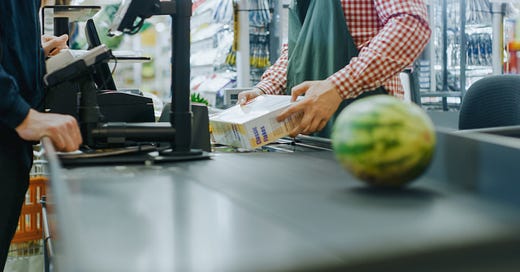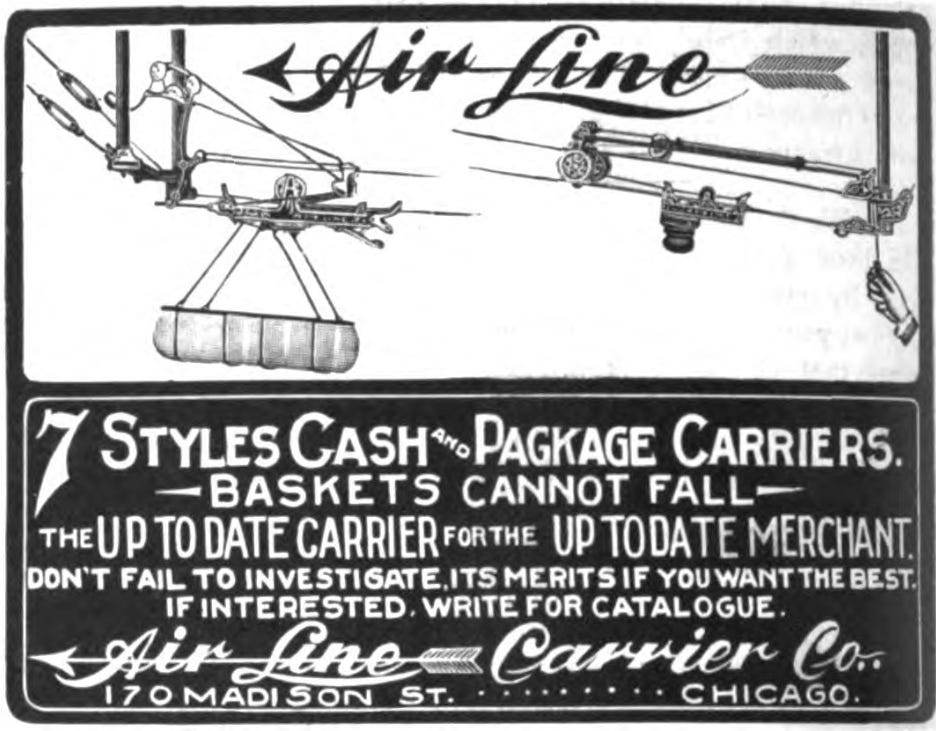Shopping History from Cash Boys to Self-Checkout
Technologies, trust, and predicable panic. Plus a 17th-century retail innovator par excellence.

My latest article, which appears in the WSJ’s Weekend Review section, delves into some of the history of cashiers, checkout technologies, and social trust. Here’s the opening.
On June 26, 1974, Sharon Buchanan, a supermarket cashier in Troy, Ohio, made retailing history when she became the first person to ring up a sale by scanning Universal Product Codes, rather than punching keys on a cash register. Fifty years later, we take bar-code scanning for granted. It is the normal way to check out in most stores.
The question today is whether the person doing it is a store employee or the customer. More than half of U.S. food and grocery retailers have self-checkout systems, as do about a third of convenience and fuel outlets, according to a 2023 survey by market-research firm Incisiv for NCR Voyix. Another 37% of convenience stores are testing or scaling up self-checkout.
The cashier position is one of the most important—and trickiest—in retailing. Cashiers must balance speed, accuracy and security while leaving customers with a positive impression. Innovations at the cashier stand do more than increase productivity or profit. They reflect and shape culture.
Before continuing this post, please read the rest here (free link).
Because of its print edition, the WSJ has strict article limits, and my editor did a heroic job of trimming an article I’d already cut—but not nearly enough—from its original form. The edited article is also more focused on the evolution of the familiar register checkout system. But some fun detail about 19th-century alternatives got left on the cutting-room floor. Here’s some of what was lost:
With their hundreds of clerks, the great 19th-century emporiums needed more scrupulous systems. Their fundamental instrument was the handwritten sales slip, with each clerk allocated an individual record book. In a 1907 article about working in a department store during the Christmas rush, journalist Rheta Childe Dorr explained the brief training she received on her first day.
“Picking up a piece of chalk and working very rapidly,” she wrote, the trainer “proceeded to show us what to write on our sales slips if Mrs. Henry Smith, of No. 1125 Fifth avenue, purchased a pair of shoes for $5 and had them sent C.O.D.; if a cash customer bought four yards of lace, at 25 cents a yard, and carried the parcel home; or if George Baker of New Brighton, Staten Island, indulged in a sweater at $3.50 and had it charged and sent.”
The most prosperous and trusted customers could charge items, but most people had to pay cash, either on the spot or on delivery. Some customers, enraptured by the joys of shopping but lacking money to do more than fantasize, would give false addresses on C.O.D. purchases. Although better than shoplifting, the scam wasted employees’ time. Immediate payment was most reliable—but collecting cash was neither fast nor simple.
To limit theft and confusion, specialized cashiers took money, sometimes in the same department but often at a central desk. The clerk would ring a bell and yell to summon a cash boy or cash girl, who would run the money and sales slip to the cashiers and return with change. Like the 13-year-old hero of Horatio Alger Jr.’s novel The Cash Boy, most were in their early teens.1
Shouting clerks, ringing bells, and dashing couriers made for a chaotic scene, especially during busy seasons. Money could easily be dropped and lost, with poorly paid clerks expected to make up discrepancies. To streamline the process, William Stickney Lamson, a Massachusetts shop owner, invented a system that carried money in hollow balls along a series of cables attached to the store ceiling. Patented in 1881, the ball system grew into an international company offering a variety of cash carriers, including pneumatic tube systems for multistory businesses.
“You cannot get money into the till too fast,” advised a 1901 article in the Chicago Dry Goods Reporter, recommending the installation of cash carriers. Sales clerks shouldn’t lose time before helping the next customer. “The average days will care for themselves, but it’s the days when people are standing around, with money to spend, trying to get some one to wait on them that time counts.”
Atlas Obscura has a nice article on “The Rise and Fall of the Cash Railway,” and there’s an entire website (very turn-of-the-century hobbyist style) on cash railways and pneumatic tube systems.
Also lost, the aside identifying Lola Smallwood-Cuevas, the sponsor of the anti-self-checkout bill in California, as my own state senator. As a typically ignorant L.A. voter, I couldn’t have told you that before I worked on the article.

One of the book ideas I’m considering is a history of shopping in retail markets (i.e., through one or more intermediaries, not the direct producer). It would begin in roughly the 17th century and take an international perspective to permit comparisons.
Unlike my previous related work in The Substance of Style and The Power of Glamour, this book wouldn’t focus primarily on consumer motivations but on social interactions. Shopping blurs the public and private. It’s an everyday arena in which people interact, directly and indirectly, with strangers. As a result, the customs, conventions, mores, and institutions that evolve as we shop express—and in some cases change—how cultures address fundamental social questions. These include norms of equality and respect, expectations of safety and comfort, and boundaries of credit and trust.
I haven’t yet written a full-blown proposal, although I’ve done a sort of pre-proposal outline, because I haven’t yet decided whether this project will work. Before the 19th century, it’s hard to get documentation on what the experience of shopping was like, as opposed to what people bought or owned. (Historians of consumption do a great job of mining probate inventories and criminal cases.) Yet the roots of modern shopping are in the 17th century.

Mitsui Hachirobei Takatoshi founded the world’s oldest department store around 1673! He was quite an innovator. He introduced single prices (no haggling) and cash-only purchases. Instead of concentrating on fickle aristocrats who paid up only twice a year, he concentrated on selling to commoners, who were becoming increasingly affluent. He sold cloth wholesale to smaller provincial stores at a modest markup, allowing him to stock greater variety. He opened branches in Kyoto and Osaka, creating a small chain. Rather than the standard lengths used for kimono, the store sold cloth in whatever length a customer wanted—but at a higher price per unit.
“They sell velvet by one-inch squares, brocade large enough to make a tweezer case, or red satin enough to cover s spear insignia,” wrote the novelist Ihara Saikaku in 1688 (translation by John G. Roberts in Mitsui, from which I take this information.) By 1700, his store was the largest in Japan. “To look at the shop owner, he appears no different from others, with his eyes, nose, and limbs in the usual arrangement,” wrote Saikaku. “This is an example of a really big merchant.”
The store has evolved—and it formed the basis for a much larger banking and industrial empire—but it’s still in Tokyo today, as the Mitsukoshi department store.
Unfortunately, essentially none of this blessedly short novel takes place in the store.






Great stuff. I was wondering recently why the iconic southern grocery chain is called "Piggly-Wiggly." The simple answer seemed to be that the founder thought--correctly--that it would be memorable. But that led me into some fascinating revelations. That Piggly-Wiggly was the first to use grocery carts because they were the first grocers who enabled/required customers to pick their own items off the shelves, rather than asking a clerk to retrieve them (in the fashion of an old-school librarian). They correctly figured that this arrangement would spur highly profitable impulse buying. This also necessitated the creation of a new class of employee--the checkout clerk--and the posting of prices on individual items. (The whole self-service arrangement was patented.) This, in turn sent packaging and name-brands to the forefront of marketing. After some missteps, the founder left Piggly-Wiggly and started another concept store--Keedoozle--a sort of grocery automat that aimed to fully automate the checkout system via electronic circuitry. It quickly failed, as 1937 technology was not up to the task. But the concept was fascinating. (I'll probably post some version of this note at Bastiat's Window, but I suspect you could find a rich vein of material in this history.)
When I first started flying, United Airlines still used a pneumatic tube system when you bought a ticket at LAX. They would put your money in a cylinder along with the cc of the ticket, insert it into the tube system, and your change would come back in a couple of minutes. I think they had this as late as the 1990's; I bet they took the tubes out when they remodeled Terminal 7 at the end of that decade and went to all credit card payment.